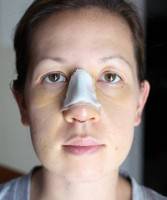Spreader Graft For Crooked Nose
Spreader Grafts for Nasal Valve Collapse
Spreader grafts work well in certain types of nasal valve collapse. Sometimes surgeons will use butterfly grafts to open the nasal valve.
It all depends on how extensive the collapse is. I like to use the open technique when performing nasal valve surgery as to the exact anatomic area of collapse. (Oleh Slupchynskyj, MD, FACS, New York Facial Plastic Surgeon)
Is a Spreader Graft Necessary to Fix Nasal Valve Collapse?
Since we can not examine you over the internet I recommend additional in person consults.
Your questions are to specific to answer over the internet. (Darryl J. Blinski, MD, Miami Plastic Surgeon)
Is a Spreader Cartilage Graft Necessary to Fix Nasal Valve Collapse?
Spreader grafts are The answer as you pointed out.
Depending on their position along the upper portion of the septum they can increase the distance between the side wall and the septum making breathing easier and correcting collapse, they can correct crookedness of the upper septum, they can length the nose.
If you are sure your surgeon does not want to use them and that you did not misunderstand him you may wish to obtain a second opinion. (Peter A. Aldea, MD, Memphis Plastic Surgeon)
Spreader grafts and and finding a surgeon who is good at this.
Very often patients need spreader grafts since when the hump is removed there tends to be collapse of the middle 1/3 of the nose. (Toby Mayer, MD, Beverly Hills Facial Plastic Surgeon)
Nasal Valve Collapse and Spreader Grafts
The internal nasal valve is the angle formed between the top portion of the cartilaginous nasal septum and the upper lateral cartilages (ULC’s: the structural cartilages right below the nasal bones). In situations of surgical or physical trauma, this valve may be compromised or narrowed. A spreader graft is a technique will allows for a wedge of “shim” of cartilage to increase the distance between the septum and ULC, thereby increasing the angle of the internal nasal valve. In other circumstances, the external nasal valve, which sits at the superior lateral portion of the nasal ala can be compromised for various reasons.
In cases where excessive lower lateral cartilage is removed, external valve function can be improved with cartilage grafts. Spreader grafts are applicable in some situations of nasal valve collapse, and in situations where the top of the nasal septum is deviated (for strengthening purposes). (Stephen Prendiville, MD, Fort Myers Facial Plastic Surgeon)
The spreader graft is the secret to correction of internal valve collapse
The internal valve is the area along the nasal bridge just above the tip of the nose, about one third the way up from the tip. This is a critical area for nasal airflow. If you have doubt, just gently pinch this area and you will notice a large reduction in airflow.
The pinch in the valve was a recognized problem in the 70″s and the spreader graft, which is used in both closed and open rhinoplasty is the standard to ‘spread’ open the valve and restore airflow. The grafts can also be layered to straighten a nose. Few if any experienced rhinoplasty surgeon would question the utility of the spreader graft. (Peter E. Johnson, MD, Chicago Plastic Surgeon)
Spreader grafts are the most common but not the only treatment for the nasal valve
I prefer to use spreader grafts for most patients with internal nasal valve (pinched nose) problems. Spreader grafts also work well in straightening out crooked noses. However there are a number of methods used that can also treat nasal obstruction (blockage). An experienced revision rhinoplasty specialist can discuss both their preferred methods and other options as well as open vs. closed approach with you. (Steven J. Pearlman, MD, New York Facial Plastic Surgeon)
Spreader graft to fix internal nasal obstruction
Spreader grafts are commonly used for internal nasal obstruction secondary to internal nasal valve narrowing/collapse.
Most rhinoplasty surgeons would discuss this option with you and explain why they would or would not choose this approach.
Depending on your nasal anatomy, there may be other options. My recommendation would be to discuss all options with your facial plastic surgeon for a better understanding of the best approach for your nose. (Jon E. Mendelsohn, MD, Cincinnati Facial Plastic Surgeon)
Spreader grafts to correct valve collapse after rhinoplasty
I can see that you have done your homework. That is great. Valve collapse is not a single problem so there is not a single approach that will work for every patient.
If the nasal vault is too narrow and the sidewalls are collapsed inward then a spreader graft would be appropriate.
You might need other work done as well to improve your nasal airway such as septoplasty, reduction of the turbinates or lateral crural strut grafts or a lateral nasal wall reconstruction depending on the amount of collapse and the location(s) of the collapse.
A thorough evaluation of the problem should elucidate the best approach to correct this.
All of these options should be raised with your surgeon as you seek a consultation.
Unfortunately this is a fairly common problem, but we have a better understanding now of how to avoid this and how to repair it. (Gregory Branham, MD, Saint Louis Facial Plastic Surgeon)
Nasal valve collapse
A spreader graft, described by Jack Sheen, MD in the ’70’s, has been the gold standard for a decreased airway and nasal valve collapse. If your nose is curved on the side needing the spreader graft, you will notice improved straightening of your nose.
Certainly an internal/closed approach can be used, although an open rhinoplasty may allow for better visualization and precise placement of the graft. (Ricardo Izquierdo, MD, Seattle Plastic Surgeon)
Revision rhinoplasty with spreader grafts
The use of spreader grafts is the most typical way to treat nasla valve collapse. You should be sure the doctor is very experienced in revision rhinoplasty. Also, I would estimate that most would do your revision open these days. (Richard P. Rand, MD, FACS, )
Spreader Graft Needed in Rhinoplasty
In most cases, a spreader graft is not needed in primary rhinoplasty. However, I usually use it to correct internal nasal valve collapse after secondary rhinoplasty.
It is also indicated for the deviated nose as well as correction of functional deformity from a secondary rhinoplasty, or if you want to widen the dorsal aesthetic lines. In most primary rhinoplasty patient cases, it is not necessary and does create a wider dorsum which is aesthetically unpleasing. (Rod J. Rohrich, MD, Dallas Plastic Surgeon)
Spreader Grafte for Nasal Valve Collapse
If the diagnosis is internal nasal valve collapse, spreader grafts will improve breathing. As most things in life, there is more than one way to accomplish your goal.
Some physicians would use an open technique and different grafts. If it will make you more comfortable, get a second opinion.
You mention that your nose is crooked – ask your surgeon if this is contributing to your compromised breathing. (Richard W. Fleming, MD, Beverly Hills Facial Plastic Surgeon)
Internal Nasal Valve Collapse In Rhinoplasty Has Numerous Methods Of Graft Correction
Spreader grafts are but one method of managing internal valve collapse in rhinoplasty, although it is by far the most common. There are other graft methods including the butterfly graft resorbable spacers and even dermal grafts instead of cartilage.
Each plastic surgeon has their preferred method based on their own experience. Given your question it would be important that you understand exactly what has been recommended.
What effect that method would have on improving a crooked nose requires further explanation. (Barry L. Eppley, MD, DMD, Indianapolis Plastic Surgeon)
Spreader grafts work
Spreader grafts are a very effective way at opening the internal valve and improving nasal airway breathing.
The cartilage used can come from your nose (septum or preserved upper lateral), ear, or in rare cases your rib. (Farzad R. Nahai, MD, Atlanta Plastic Surgeon)
Rhinoplasty spreader grafts
Spreader grafts are commonly used to correct nasal valve collapse and indeed may also be useful for correction of a crooked nose especially where extensive septal work needs to be done. (Andrew Pichler, MD, Sacramento Facial Plastic Surgeon)
Spreader graft for internal nasal valve collapse
You are correct – spreader grafts are used for internal nasal valve collapse.
However, before you completely discount your surgeon – I’d encourage you to communicate with him/her. Because he/she is the only person who has examined you, I would ask him/her to explain what they feel your anatomic problem is and how the graft will help fix this problem. You should always feel 100% before proceeding with surgery. (Catherine Huang-Begovic, MD, Beverly Hills Plastic Surgeon)
Use of spreader grafts depends on your problem
Spreader grafts are great for preventing the middle part of the nose from becoming too narrow. I also feel that in most patients, spreader grafts also help improve the patient’s breathing. However, some surgeons feel that butterfly grafts are more effective in preventing internal nasal valve collapse. I am not one of those surgeons, but most likely yours is. Regarding a crooked nose, neither graft will correct a crooked nose unless the graft is placed assymetrically or only on one side.
Ultimately, if your surgeon is an experienced rhinoplasty expert, I’m sure you are in good hands. (Andrew Campbell, MD, Milwaukee Facial Plastic Surgeon)
Correction of acute internal nasal valve angle
Correction of a tight internal nasal valve requires one of two maneuvers, placement of spreader grafts like you have proposed or rolling in of your upper lateral cartilages. Which of these maneuvers will suit you best is dependent on the width of your nasal dorsum. (Arian Mowlavi, MD, Laguna Beach Plastic Surgeon)
Spreader graft
If you have an internal valave collpase, usualy a spreader graft is the best solution of the affected side. (Steven Wallach, MD, Manhattan Plastic Surgeon)
Is a spreader graft needed to fix internal nasal valve collapse?
It’s a not uncommon scenerio for a patient with a nasal hump reduction to eventually develope internal valve collapse in the middle third of their nose if a spreader graft isn’t placed at the time of surgery.
A spreader graft can be placed secondarily, like in your case, during a separate procedure if needed. There are other types of grafts or sutures that some use to help with valve collapse. It may help if the surgeon you spoke with explained what he was planning on doing more precisely.
Improving the narrowing in the middle third of the nose can improve the symmetry of the nose as well. The shadowing that the collapse creates can cause the nose to look crooked. (Thomas A. Lamperti, MD, Seattle Facial Plastic Surgeon)


